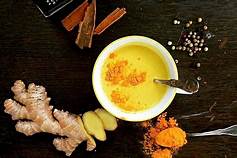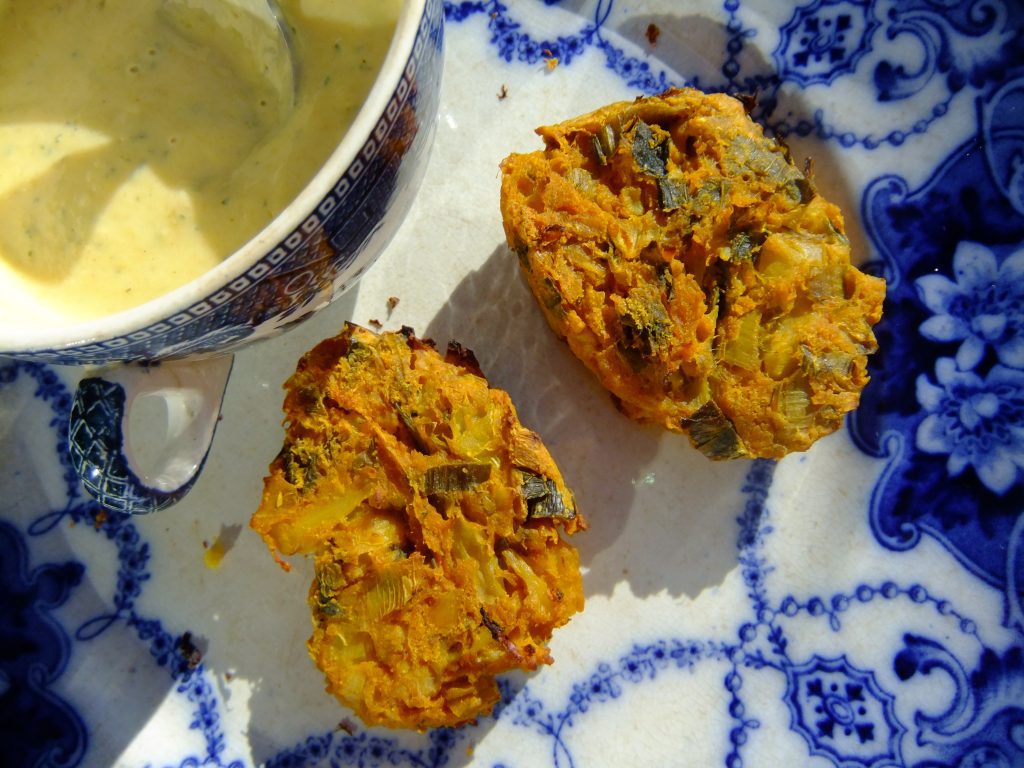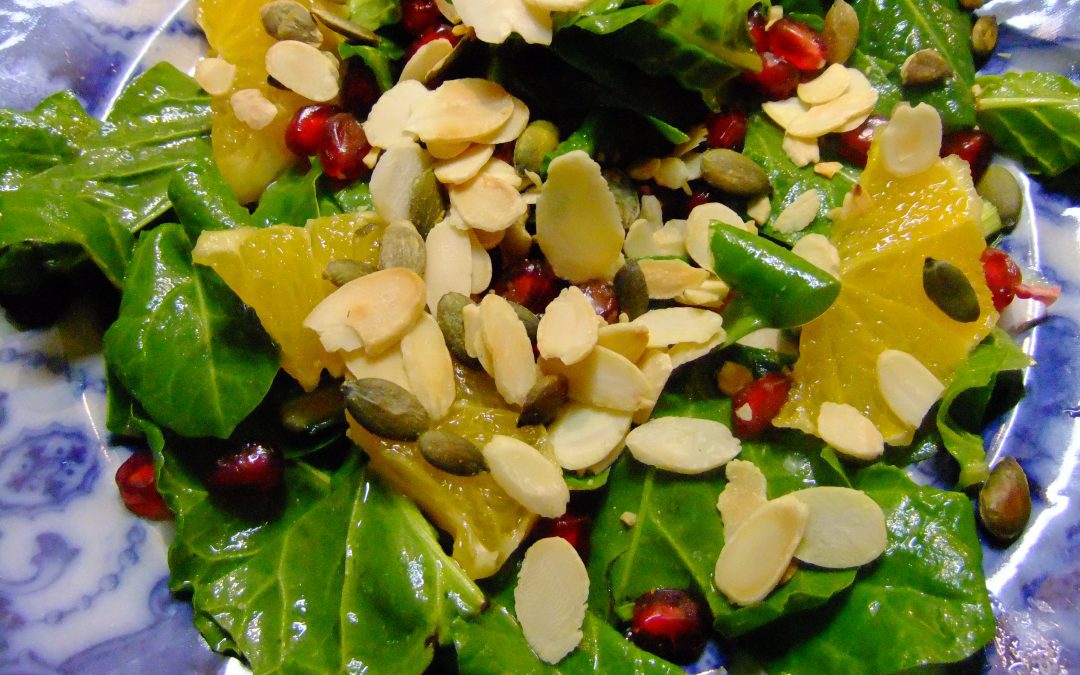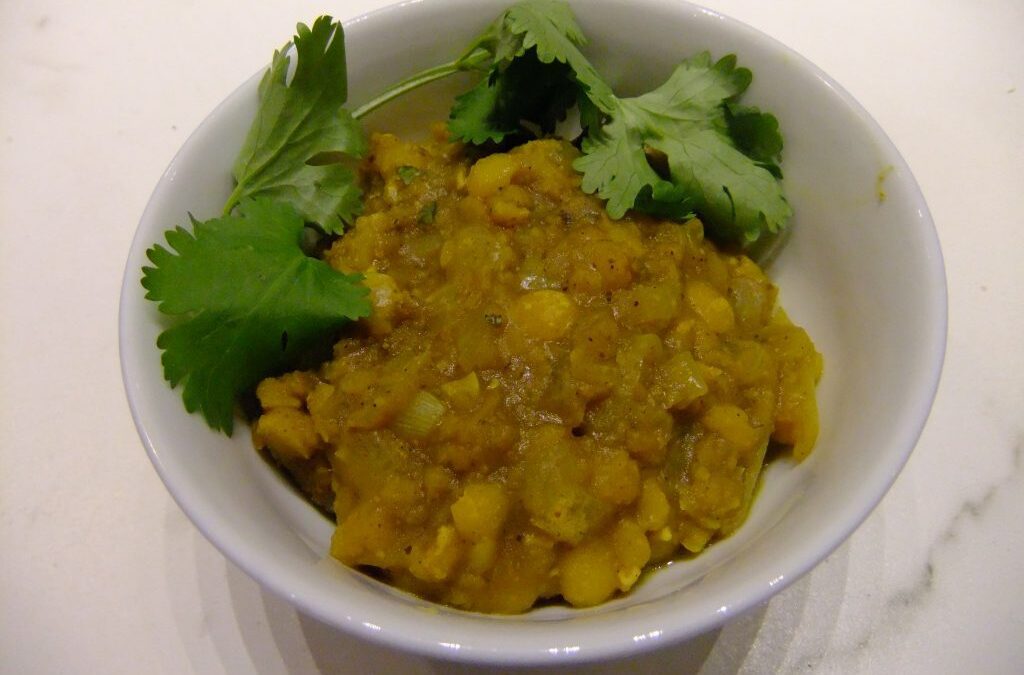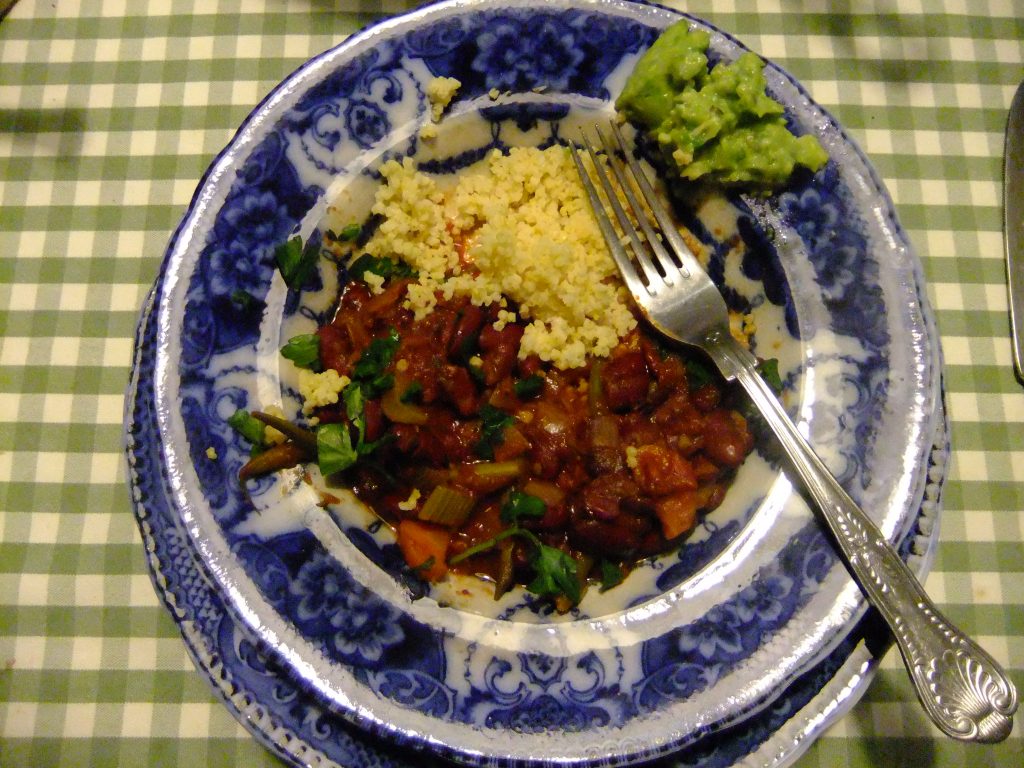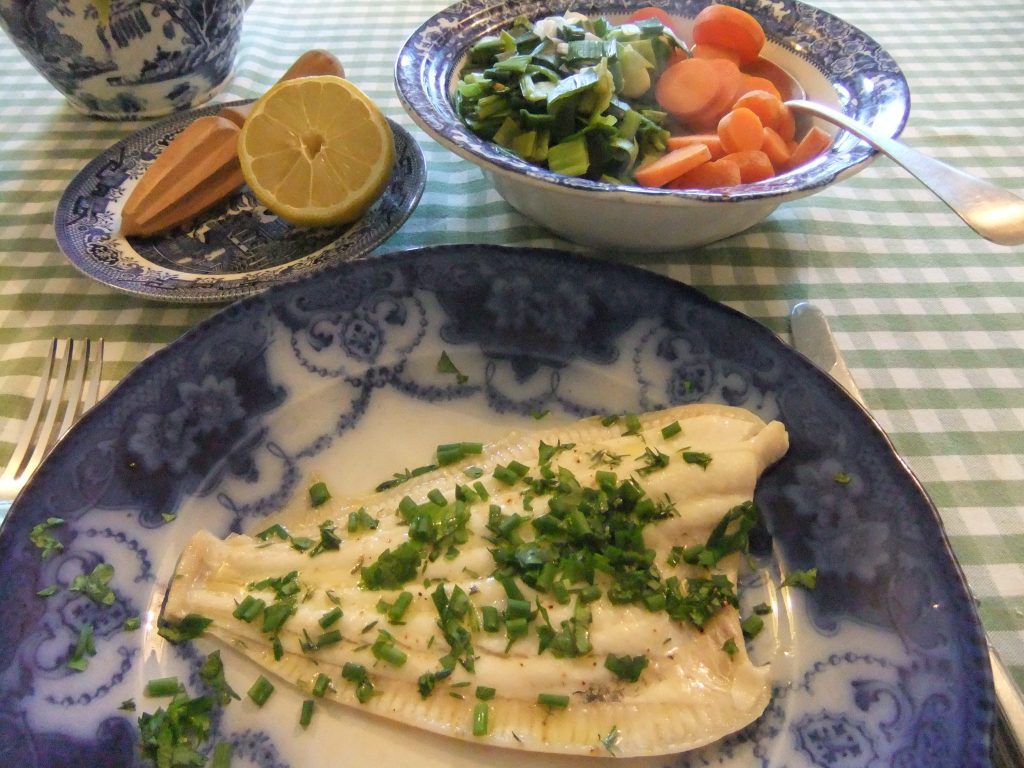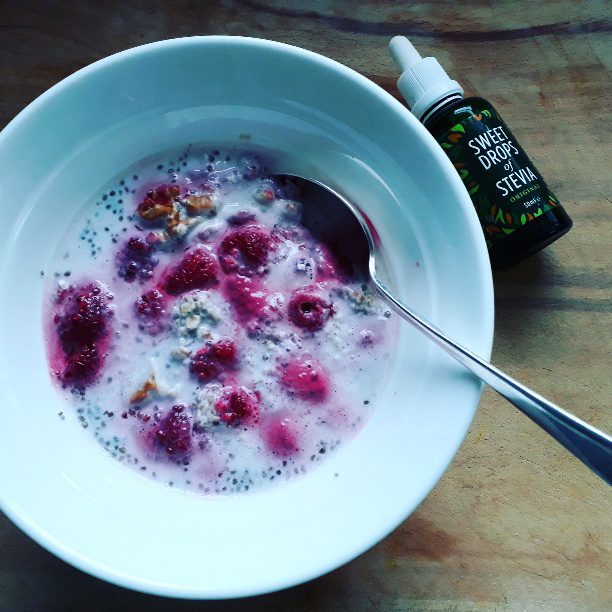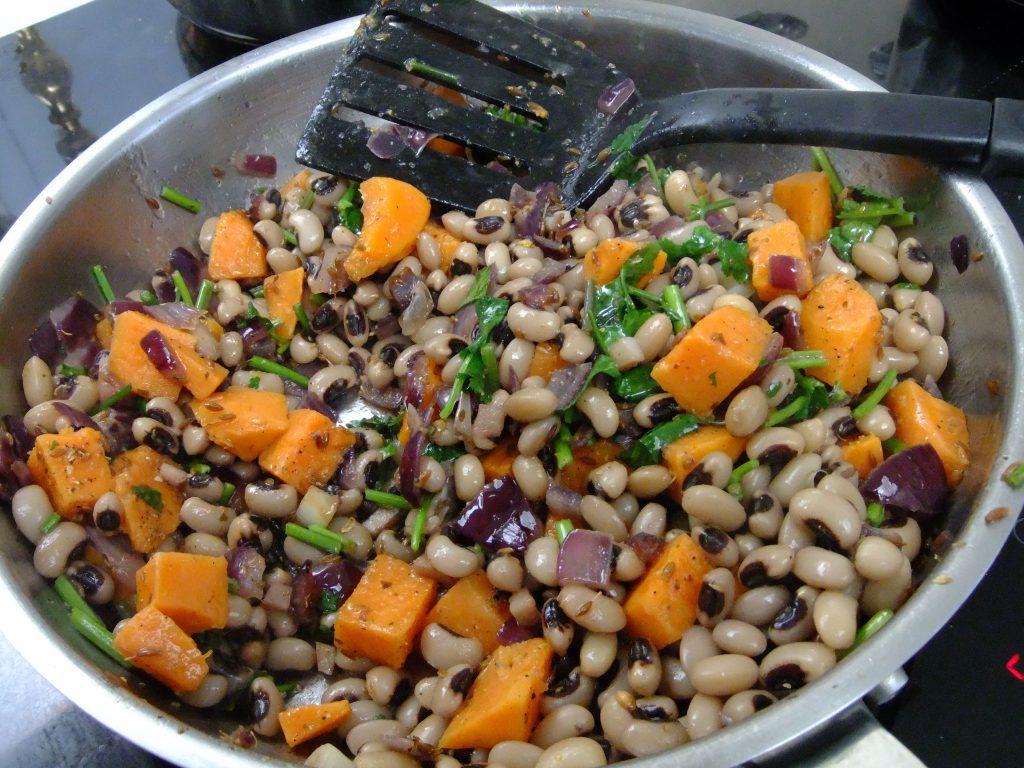
Dec 20, 2017 | Anna's Best Recipes, Main courses
I was in a hurry last week and came up with this. Its super-fast on a weekday, provided you’ve already made up the Cajun spice mix (which only takes a couple of minutes). I’ve posted this mix already on the blog but its so good it deserves a reminder. I use it (when I remember) for grilling chicken fillets, salmon darnes and sometimes lamb chops. Rub the fish/meat with lemon juice first so the spice blend sticks on.
For 2:
2 hake fillets or darnes, about 160g each
Smoked paprika
Large bag of black kale (Cavolo nero) or curly kale
Sundried tomato paste, dairy-free red pesto (or if you are not dairy-free or on SC diet any good quality tomato pesto will do)
Fresh lemon juice (you will need about a teaspoon for the fish)
Extra virgin olive oil
Cajun spice mix:
You will need tinfoil and a roasting tin or dish
For the Cajun spice mix (store in an airtight glass jar away from heat and light)
½ level tsp chilli powder (omit or just use a pinch if you don’t like much heat)
1 level tsp Himalayan (pink) salt
½ tsp cayenne pepper
2 rounded tsp dried thyme
1 tbs each of:
Coarsely ground black pepper
Dried basil
Dried oregano
Ground coriander
Optional extra:
Cauliflower mash (see post) to serve
1. Turn on the oven to 200C.
2. Prepare the kale – wash, destalk and slice thinly. Boil your kettle and put the kale in your steamer over at least 2cm of boiling water. It can take quite a while to become tender.
3. While the kale is steaming, put the fish skin side down in an roasting dish with deep sides, rub the fish fillets with some lemon juice. Sprinkle Cajun mix and a good pinch of smoked paprika on each fillet until well coated.
4. Cover with tinfoil and give it 10 minutes in the preheated oven. After 10 minutes, test with a skewer to see if it is tender (this depends on the thickness of the fish). If not, give it another 5 minutes, covered again with the foil to stop the fish drying out.
5. Meanwhile, warm a vegetable dish for the kale. Into the dish put a generous heaped teaspoon of the pesto or paste, a dessertspoon of extra virgin olive oil and a good twist of black pepper if you have some. As soon as the kale is done to your liking toss with the pesto/paste to coat and keep warm.
6. Serve the fish on top of a pile of kale.
Optional extras:
Cauliflower mash (see blog post). This freezes well. I like to make a big batch then freeze leftovers in single portions. Reheat in a saucepan, stirring from time to time.
Why this is good for you
Herbs and spices are a powerhouse of vitality-boosting qualities. They protect the food during cooking from generating toxic inflammatory compounds (e.g. amines) while also protecting ourselves and our brains from accelerated ageing. Herbs and spices have hundreds of times stronger antioxidant properties than fruit and veg, weight for weight. Kale is a dark green leafy veg so its rich in magnesium and folic acid. We need both of these for making us more resilient to stress as well as for a healthy digestive system and good skin.

Jun 15, 2017 | Anna's Best Recipes, Breakfasts & smoothies, Sides, starters, soups & snacks
 How do you increase your veggie intake to help your health if you have almost no time in the evenings to prepare a full meal or you have problems chewing? Try these green smoothies. You can even make two servings and store leftovers in an airtight glass jar in the fridge for the next day. Citrus juice and airtight containers help prevent oxidation (nutrient loss and discolouration). If you don’t like your green smoothies cold you can heat these VERY gently in a saucepan until they are lukewarm.
How do you increase your veggie intake to help your health if you have almost no time in the evenings to prepare a full meal or you have problems chewing? Try these green smoothies. You can even make two servings and store leftovers in an airtight glass jar in the fridge for the next day. Citrus juice and airtight containers help prevent oxidation (nutrient loss and discolouration). If you don’t like your green smoothies cold you can heat these VERY gently in a saucepan until they are lukewarm.
Garden walk (950ml or 2 servings)
1 cup baby spinach, packed
1 cup fresh parsley (any type), packed
2 large ripe tomatoes
2 tbs freshly squeezed lemon juice
½ avocado
¼ tsp chilli pepper (can cause flushing so avoid if you have rosacea)
Optional: a cupful or so of filtered, boiled and cooled, or bottled spring water to help everything go round in the blender. Wash and chop everything roughly. Blitz well.
Cucumber dill-icious soup (950ml or 2 servings)
1 large cucumber
½ a small bunch of dill (or use fresh basil if you like)
1 small avocado
3 leaves curly kale, stalks removed
1 large stalk celery
½ lime, juiced
2 cloves garlic*
Wash everything and blitz everything with a little filtered, spring or boiled and cooled water to help it all go round in the blender.
Wild green pear (makes about 500ml)
1 ripe Bartlett or Williams pear (these are lovely and sweet)
1 cup local greens (e.g. rocket, organic baby spinach, lettuce, kale, watercress, beet tops, young dandelion greens)
1 cup water
1 heaped teaspoon sunflower seeds, pumpkin seeds or 8 blanched almonds
Wash, roughly chop and blitz the fresh produce with the water and sunflower seeds.
Salad smoothie idea (or “make this up as you go along”)
Blitz a large handful of roughly chopped green leaves, a tomato, celery stick, heaped dsp chopped red onion, clove of garlic, half a red or green pepper, a glug of extra virgin olive oil, a squeeze of lemon and a generous splash of tomato juice from the carton. Add Himalayan (pink) salt and fresh ground black pepper to taste.
Green gazpacho (makes about 3 large servings)
A green take on the traditional chilled Spanish summer soup. Quite filling.
1 bunch spring onions
3 cloves garlic, roughly chopped*
1 small green pepper (stalk and seeds removed)
100g organic baby spinach ½ romaine lettuce (or any lettuce other than iceberg)
1 avocado
Small bunch fresh coriander
1 small green chilli, halved and deseeded (optional)
50g ground or blanched almonds
3 tbs extra virgin olive oil
3 tbs apple cider vinegar/1 of white wine vinegar and 2 of sherry vinegar
200ml water (filtered, boiled and cooled, or use bottled spring water)
Himalayan (pink) salt
Freshly ground black pepper to taste
Optional: 3 tbs home-made kefir or natural yoghurt (or use unsweetened soya/almond-based yoghurt if you are avoiding dairy due to sensitivity or skin health issues)*
Wash and roughly chop the veggies, leaves and herbs. Put into your blender processor with the 3 tbs olive oil, the citrus juice/vinegar, 200ml water and whizz to a thick puree. You might have to do this in 2 batches. Taste for seasoning. If it’s a bit bland then add salt, freshly ground black pepper and maybe more lemon juice/apple cider vinegar or olive oil. It’s the amount of seasonings that makes this a great soup. Serve chilled with another generous slug of extra-virgin olive oil.
For more great green smoothies buy Victoria Boutenko’s “Green Smoothie Revolution” available on www.bookdepository.com (postage is free). If you make smoothies which include a piece or two of fruit, always include some protein/good fats (e.g. nuts, seeds, avocado, coconut oil) to avoid sudden dumps of sugar in your bloodstream that compromise digestive/skin health and energy.
What’s good about green smoothies
Green veggies are rich in magnesium needed for healthy skin, a chilled mind and plenty of energy. They are giving you a range of skin-supporting, digestive-system healing and vitality boosting phytonutrients.
*Garlic is a natural antibiotic. But unlike antibiotic medications, it helps healthy bacteria in your gut to flourish and lowers levels of disease-causing yeasts and bacteria. If you are new to using raw garlic, start small and build up. As it kills off disease-causing micro-organisms you may notice some short-term flatulence! This will disappear over time as you keep going – replacing unhelpful micro-organisms in your gut with healthy ones to help every aspect of your health.
Organic vegetables and fruits, where you are eating the outer surface (rather than peeling) give you a little dose of healthy bacteria with every mouthful. In “conventional” produce good bacteria are absent. Herbicides kill the beneficial soil bacteria. Monsanto originally patented the bestselling herbicide glyphosphate as an antibiotic. It disrupts thyroid function, nerve function and is deeply toxic. Many “conventional” crops contain residues.
Why use filtered, boiled and cooled or bottled spring water in a smoothie? This is to avoid chlorine, that kills beneficial bacteria in your gut and suppresses thyroid function. Boiling allows the chlorine to evaporate. Chlorine, like fluoride, disrupts your thyroid function by blocking iodine. Iodine also helps prevent skin infections, PMS and hormonal cancers (e.g. breast, prostate).

May 5, 2017 | Anna's Best Recipes, Desserts & drinks
I jumped at the chance to try this recently, and (bizarrely) it’s delicious as well as having big health benefits. Although I often use turmeric in curries and my pear breakfast smoothies I was at a loss to see where I could get it in every day. Don’t miss out the black pepper, its piperine increases the bioavailability of anti-inflammatory curcumin in turmeric by 2000%! Vary the amounts of ginger and cardamom if you want. Here I give the recipe for a latte blend as well as quantities for just one cup.
DO remember to pick milks free of emulsifiers that tear the lining of your gut – in particular carageenan (E407) , carboxymethylcellulose (E466), polysorbate 80 (E433), maltodextrin (E1400). I like Ecomil brand as it’s pretty natural.
I use dairy-free milk but if you normally drink lots of cows milk with no respiratory/sensitivity issues, use your normal…
For 1 serving (see below for quantities to make up a whole jar):
200ml/1 mug of non-dairy milk of your choice (e.g. unsweetened coconut milk, almond milk)
½ level tsp (teaspoon) turmeric powder
¼ level tsp ginger powder
¼ level tsp cardamom powder
Pinch freshly fine ground black pepper (if you leave it too coarse it just stays in bottom of the mug)
Optional: Small pinch of cayenne/chilli powder
To sweeten: a few drops of stevia or half a teaspoon of xylitol/raw honey
- Heat the milk on the stove or with the electric steam milk frother on your coffee machine.
- Add the spices and sweetening of your choice, whisk to mix.Variation: If you are feeling decadent, a sprinkle of Ceylon (Sri Lankan) cinnamon on top of the latte is lovely and boost vitality even more.
Turmeric latte blend (approx. 30 servings)
Keep this in a glass jar with a tight-fitting lid in a dark place to keep potency and flavour.
90ml/6 level tbs (tablespoons) turmeric powder
30ml/2 level tbs ginger powder
30ml/2 level tbs cardamom powder 5ml
5ml/1 level tsp (teaspoon) finely ground freshly ground black pepper
Optional: 2.5ml/½ level tsp ground chilli powder
Why this is great for you
Turmeric reduces inflammation everywhere in your digestive system. A study using 1g turmeric powder twice a day resulted in a massive improvement in remission rates in inflammatory bowel disease. 1 gram is just half a teaspoon. Turmeric is also well-studied in relieving gastritis and gastric reflux and keeping your brain healthy. What’s not to like? Ginger, like turmeric, supports your liver function to help skin, energy, bright eyes and skin. And it helps reduce nausea. Chilli powder helps thicken the mucous linings of your stomach and intestines. Chilli is used successfully in Ayurvedic medicine to heal stomach ulcers and gastritis! Its usually not the spices in “spicey food” that make people feel bad – it’s the large amounts of toxic, cheap refined oils your average Indian takeaway or restaurant uses in the cooking. Ceylon/Sri Lankan cinnamon (not “cinnamon” from supermarkets, which is in fact the cheaper cassia) has remarkable health effects. Like ginger, it can help prevent diabetes (or tackle it) but it also reduces “bad” bacteria and yeast (candida) overgrowth in your gut. Most spices have a selective effect on your gut bacteria – helping encourage growth of “good guys” and inhibiting disease-causing ones. Helpful bacteria in your gut make natural anti-bacterial and ant-viral substances like interferon gamma which travel to wherever you have an infections and help see it off.
This would be a great drink for someone with a cold or flu as it’s anti-viral and anti-inflammatory.

Feb 17, 2017 | Anna's Best Recipes, Sides, starters, soups & snacks

Gluten-free baked cauliflower bahjis
I’ve been craving bhajis that are not deep-fried and finally got my wish with this lovely oven-baked recipe. This recipe is slightly adapted from one by Susanna Booth in the Guardian. Great for a buffet, finger food for a party, as a starter, or cold for a picnic. Everyone’s happy to eat it and take seconds. They
don’t need to know that its both gluten-and dairy-free! I like these just as much cold as hot.
NB some mango chutneys contain malt vinegar, which contains gluten, so read the label carefully before you buy.
Makes 15-20
For the bhajis
300g cauliflower
2 medium leeks, green and white parts
1 tbs olive oil (or, even better, virgin coconut oil)
100 gram (chickpea) flour
1 rounded tsp (teaspoon) ground turmeric
1 level tsp ground coriander
1 level tsp ground cumin
A pinch of Himalayan or Atlantic Sea Salt
80ml water
2 tsp mango chutney (make sure it’s a gluten-free one that does not contain malt vinegar) OR 2 rounded tsp St Dalfour or Follain no added sugar apricot jam and a pinch of ground ginger OR 2 tsp unsweetened mango puree (you can do this by blitzing the mango for the dip and reserving 2 tsp for the actual bahjis).
2 rounded tsp tomato puree
Olive oil (or even better, virgin coconut oil) for greasing the baking tin
For the dip
100g natural soya yoghurt (or natural yoghurt or thickened kefir for for milk-eaters)
Half a ripe mango
1 rounded tbs (tablespoon) mango chutney (again, make sure it’s gluten-free)
5 fresh large mint leaves
1. Preheat the oven to 180C. Wash and prepare the cauliflower and leeks. Dice the cauli into tiny pieces; cut the leeks lengthways and then into thin slices. Sweat all the veg in the olive oil in a heavy bottomed pan, covered with a lid, for 5-10 minutes until just softened.
2. Put the gram flour, spices and salt in a bowl. Add the water, chutney and tomato puree and mix to a smooth paste. Add the sweated vegetables and stir until everything is well coated. It will be very thick.
3. Drizzle a little olive oil over a taking tray. Rub with a spatula or brush to coat the whole surface.
4. Dollop the bhaji mix on the tray 1 tbsp at t time. Flatten them a little with the back of a spoon, spatula or fishslice.
5. Bake for 10-15 minutes until slightly browned. Take the tray from the oven, then flip each bhaji over using a fish slice. Bake for another 10-15 minutes until golden. You can eat them hot or cold.
6. Make the dip by blitzing the chutney, mango, mint and yoghurt together in a mini food processor or else use a bowl and stick blender. Refrigerate for up to a day before serving.
Variation:
I made an imitation mango chutney for this recipe by mixing a few things I had in the cupboard: 1 1/2 tbs St. Dalfour apricot jam, a pinch of onion salt, a large pinch of each of dried garlic and ground coriander and 1/2 teaspoon of distilled or wine vinegar.
Why this is better for you:
Gram (chickpea) flour is a good source of protein to help keep you feeling fuller for longer. Leeks are rich in inulin, which helps feed good gut bacteria. Good bacteria are important for all aspects of your health from weight management to clear skin and good digestion and absorption of nutrients. Because these bhajis are baked rather than deep fried which means they don’t toxic heated polyunsaturated oils. In cooking, coconut oil is even better for you then olive oil. This is because coconut oil is less damaged by heating then olive oil. coconut oil is rich in medium chain triglycerides, which can help boost energy because the body digests them very easily. Amazingly, coconut oil is used by your body directly to make energy rather then being stored as fat in your body. This makes it a better tool for weight management than many other oils. Herbs and spices such as turmeric, cumin and coriander have well-documented anti-inflammatory properties and a great health boost for anyone who cares about their health, fitness or skin.

Jan 5, 2017 | Anna's Best Recipes, Sides, starters, soups & snacks

Spinach pomegranate & orange salad
I stole this salad from a newspaper and adapted it to include some protein (flaked almonds) so you’re not just getting a huge blood sugar spike from all the fruit. This makes a lovely starter before a winter stew of some sort. Or else make a big platter of it for a buffet meal. The colours are stunning. Pomegranates are still in season in January (they start in November in Asian shops and good greengrocers). If you can’t get pomegranates then either increase the orange to a whole one or substitute a tablespoon of goji berries soaked overnight in clean water.
2 large handfuls baby spinach, washed and dried
1 tbs pumpkin seeds (for SC diet initial 12 weeks use almonds instead)
1 tbs flaked almonds
1/2 a small orange
A fresh pomegranate (you will use 1/4 to half of the seeds)
Dressing:
3 tbs virgin hazelnut or walnut oil (or use extra v. olive oil at a push)
Juice of 1 small orange
Freshly ground black pepper
Pinch of Himalayan/Atlantic Sea Salt
1. On a very low heat in a heavy bottomed pan, gently dry the pumpkin seeds and flaked almonds, until they seem dry and the pumpkin seeds are slightly swelled. It is better to eat nuts and seeds raw but this light toasting does make them super delicious. Remove from the heat as soon as they are slightly dried and crispy.
2. While this is happening, whack your whole pomegranate all over with a wooden spoon or a pestle for a few minutes. This loosens the seeds. Then cut it in half and pick out the ruby-coloured seeds.
3. Cut your orange in half across its equator, cut off the skin and pith with a sharp knife. Cut the remaining piece in half, then slice as thickly or as thinly as you feel like.
4. Mix your dressing in a screw top jar and shake to amalgamate.
5. Now put half the pomegranate seeds, the orange, spinach, and at least a tablespoon of dressing in a large bowl and toss until coated and glistening.
6. Divide between two plates, adding more pomegranate seeds if you think there’s not enough for your liking. Sprinkle over the almonds and pumpkin seeds. Enjoy…
Why this is good for you:
Spinach, like all dark green leafy veg, is rich in folic acid. Folic acid is important for your liver, helping keep your skin clear and healthy. Its also important for your mental health, helping reduce stress levels. Pomegranates are high in antioxidants and the raw, virgin cold-pressed oils are a good source of omega 6 oils and vitamin E for beautiful skin. Don’t forget to keep your virgin nut/seed oils in a cool dark place in an airtight bottle, so the delicate beneficial oils don’t get damaged. Pumpkin seeds are a rich source of methionine (and zinc) which helps clear heavy metals and other toxins from the body. Almonds are high in calcium and magnesium for good stress management and clear skin.

Dec 14, 2016 | Anna's Best Recipes, Main courses

This is a lovely, warming dhal, the earthiness balanced by the lemon juice (my other yellow split pea dhal recipe uses tomato and apple to lift it). Make a double portion and freeze half for another dinner. I’m eating more of this sort of meal in the run-up to the great Christmas splurge in a couple of weeks.
Make a double quantity and store leftovers in the freezer for another time.
For 2:
100g (about half a large mug) dried yellow split peas
1.5 cm fresh ginger, grated on the fine side of your grater
1 onion, peeled and chopped
1 dsp coconut oil
1 level tsp cumin, ground
½ tsp turmeric
1 clove garlic, crushed or chopped
2 bay leaves
1 level tsp mixed spice
Juice of ½ lemon
Freshly ground black pepper
1. Cook the split peas in 3 times their volume of water along with the ginger, until tender (do not allow to dry out completely). This takes around 15 minutes.
2. Meanwhile, sweat the onion in a covered pan with the oil and 1 dessertspoon of water, when the onions are translucent, add all the spices, bay leaves and garlic and stir for a minute.
3. Add the split pea mixture (you may need to drain off some water) and cook until the split peas are beginning to crumble.
4. Add lemon juice and black pepper to taste
Serve with:
4 large handfuls of steamed vegetables eg. sliced kale, green beans, Brussels sprouts, wilted spinach and, if you like, some starchy carbs like roasted squash wedges, celeriac or turnip. If you are NOT on the SC diet, some brown rice is another option.
Why this is good for you
Garlic and spices are profoundly anti-inflammatory. This is partly because they help reduce numbers of disease-causing bacteria in your intestine while also promoting growth of helpful species. But spices also contain polyphenolic substances. These stimulate your body to increase antioxidant activity to keep you in peak condition and delay the ageing process. Split peas, garlic and onions contain soluble fibre which feeds beneficial bacteria. The peas are also rich in magnesium needed for great stress management, good sleep and beautiful skin (amongst other things).

Nov 10, 2016 | Anna's Best Recipes, Main courses
I love to eat this when the weather gets cold and we want comfort food in the evening. This was a family favourite cooked by my mother for many years. Kids seem to like it though you might need to omit hot chilli and cayenne and use paprika instead. Make a large batch and store leftovers in the freezer for future ready-meals.
If you don’t like kidney beans then borlotti, cannellini or butterbeans will work just as well.
For 4:
225g (1 large mug) dried red kidney beans (or 2 tins sugar free kidney beans, drained and rinsed)
1250ml water for boiling (if using dried beans)
1-2 dsp extra virgin olive oil
225g/1 very large onion, finely or roughly chopped
2 large cloves garlic, crushed
450g mixed veg, chopped (eg. red/green peppers, carrot, celery, turnip, runner beans, green beans, courgettes)
Heaped tsp dried basil
Rounded tsp ground cumin
½ tsp cayenne pepper
½ tsp chilli powder (optional – avoid if you don’t like hot spices)
400-500g passata (sieved tomatoes) OR a 400g can tomatoes, liquidized/mashed
2 tbsp tomato puree
3 tbsp red wine (optional)
Stock (liquid reserved from cooking the beans) or water
Juice of ½ lemon (optional)
Freshly ground black pepper and Himalayan or Atlantic sea salt
1. If using dried beans: Soak the beans overnight in filtered water, drain and rinse well. Bring to the boil in fresh water and boil fast for at least 10 mins so any protease-inhibitors are destroyed (you can give yourself an awful cramp and tummy upset if you don’t do this when cooking beans). Then cover the pot and simmer for a further 35-40 mins or until the beans are soft – cooking time varies. If you find the water tends to boil over, it helps to add a teaspoon of olive oil. When the beans are soft, drain and reserve the stock for use later.
2. Put the onion and garlic in a large heavy bottomed saucepan with 1 tbs olive oil and 1 tbs of water, cover with a lid and sweat for a few minutes until translucent. Then add the chopped vegetables, beans (if using tinned, do not add till later), basil and spices. Stir well, then cover and sweat (on low heat) 5 mins
3. Next add tomatoes/passata, tomato puree, red wine and 1/4 pint of the stock/water.
4. Bring the mixture to the boil, cover and simmer for 20 mins until the veg are softened.
5. Add the lemon juice and seasonings, tinned beans (rinse well first)or cooked beans. Increase the stock level if you like your casseroles fairly liquid then cook for a further 10-15 mins until the vegetables are tender.
Serve with:
- A green salad or steamed broccoli.
- Some cooked quinoa, millet or brown rice is nice with this (but avoid all of those if you are on the SC diet!). The quinoa in particular, with its 11% protein, will keep you fuller longer. If you are on the SC diet, just put a few more carrots and turnip or celeriac in the casserole for extra carbs.
- My one minute guacamole: mash a ripe avocado or two with a pinch of Himalayan or Atlantic sea salt. Add fresh lime juice to taste (one lime is usually enough for two small avocados) and if you like, a pinch of chilli or a chopped red chilli.
Why this is good for you:
Taking a break from meat and having vegetable protein instead provides food for your good gut bacteria. Maybe that is part of the reason why a semi-vegetarian diet helps people live longer. Herbs and spices all have medicinal qualities as they encourage antioxidant activity in our body – good news for reducing inflammation, helping your skin and your intestines. They also help suppress disease-causing bacteria in your gut while encouraging the growth of helpful species.

Oct 27, 2016 | Anna's Best Recipes, Main courses
This is another really quick dinner for when you don’t have a lot of time or inclination to cook. I never really liked flat fish much before seeing how Nigel Slater cooked it in his book, “Real Fast food”. Use plaice, sole or lemon sole, which will take a bit longer as it’s more robust. The same treatment is also lovely for fancy flat fish such as turbot or halibut, you will just need to cook the whole fish for longer, possibly in the oven.
The herbs aren’t crucial but they give massive health benefits (anti-inflammatory, gut-bacteria balancing, angi-ageing – the list is endless).
For 2:
2 sole or plaice fillets, about 160g each
Extra virgin olive oil – couple of teaspoons
About 1 dsp fresh thyme leaves
Optional: 3 heaped dsp chopped fresh/frozen parsley or scissor-snipped chives, or a mix of both.
A fresh lemon half, to squeeze over
Freshly ground black pepper
To serve: 6 cups steamed veg e.g. broccoli or runner/green beans OR 4 cups of greens and 2 cups steamed carrots or (not suitable for SC Diet) steamed slices of sweet potato. The orange veg give you more nutrients than in white potatoes.
1. Put your veggies in the steamer and keep warm when cooked.
2. Heat your grill to medium.
3. Brush a baking sheet or the shiny side of a large piece of tinfoil with a little olive oil and place on your grill rack, laying the fish, skin side down, on top.
4. Smear or brush the fish with the olive oil and sprinkle over the thyme leaves and a few good grinds of black pepper.
5. Grill till tender and opaque, about 5 mins. It’s done when the point of a knife goes through the fish like a hot knife through butter. The baking sheet/tinfoil helps cook the underside of the fish so you won’t need to turn it at all.
6. Manhandle the fish onto warmed plates using a fish-slice or spatula, and scatter over the parsley and/or chives.
7. Serve with the veg and a drizzle of extra virgin olive oil and hand around the lemon to squeeze over.
Variation:
You could use a small knob of butter, melted gently and brushed on, instead of the olive oil, if you want to, provided you don’t need a 100% dairy-free diet.
Why this is good for you:
White fish is a source of high quality protein that’s low in saturated fats. Herbs, especially fresh thyme, are a rich source of antioxidants that help lower inflammation in the skin (eg eczema), arteries (heart disease), and digestive system (eg. colitis, gastritis). Extra virgin olive oil, especially when eaten raw, is a great way to bump up your intake of vitamin E. Vitamin E moisturizes your skin from within. This vitamin also helps keep the blood thin, assisting circulation to the brain, hands and feet. Vitamin E has also been shown to play a part in dampening down an over-active immune system (e.g. allergies, auto-immune diseases).

Sep 23, 2016 | Anna's Best Recipes, Breakfasts & smoothies
This is just the thing for when you have a minute in the evening but no time in the morning rush. You can even make it in a glass jar with lid and take it with you to work. I adapted the recipe from one by Derval O’Rourke to have more protein and a lot less starchy carb. So it will keep you going longer and is not a weight-gainer breakfast. If you like this but find it too cool on an autumn morning, you could warm it very gently for a minute or two in a small pan before eating.
For 1:
35g gluten-free oatflakes, about 2/5 of a mug (or normal porridge oats if you eat gluten)
1 heaped tbs (tablespoon) walnuts, roughly broken up, chopped or left whole
1 heaped tbs chia seeds
1 cup frozen raspberries (or use fresh but don’t add until the morning)
10 drops pure stevia (from health stores) – optional
250 ml milk: unsweetened almond milk, thin coconut milk with no additives (or if you prefer goat’s or cow’s milk you can use that but do refrigerate overnight).
1. Put all the ingredients in a large bowl. Mix and cover with a plate or cling film.
2. Allow to stand overnight. If you used cow/goat milk store in the fridge.
3. The next morning, add another splash of milk if you fancy and enjoy.
Why this is good for you:
All grains, even oats, contain phytates. Phytates lock onto nutrient minerals like zinc, forming large molecules that can’t be absorbed into your body. Wheat contains some of the highest levels of phytates. Oats contain fewer but soaking any grain overnight dramatically reduces phytate levels. Raw berries are a powerhouse of polyphenols which help keep your body strong, healthy and young-looking. They even help toughen up a sensitive tummy or help clear your skin. Try to get organic berries if you can. Walnuts and chia seeds provide you with protein to keep you full and when they are soaked their nutrients become more available for your body to absorb. They also contain omega 3 fats and minerals to benefit your body. Unfortunately oats are steamed to make them into oatflakes so this doesn’t qualify as a totally raw breakfast but it’s still great for you.

Sep 12, 2016 | Anna's Best Recipes, Main courses, Packed lunches, Sides, starters, soups & snacks

Bleck-eyed beans with sweet potato and coriander
This is real comfort food and a great crossover dish for feeding vegetarians and carnivores at the same dinner table. It’s pretty rich in protein do if you are feeding a vegetarian its a good choice. But you can also serve it as an accompaniment to roast or grilled meat or fish. I love to eat it as a vegetarian dinner with just a simple green salad or some steamed green/runner beans drizzled with olive oil and paprika. The recipe was I think from Cafe Paradiso but I changed the recipe a bit to use non-toxic oils. Hope you enjoy it. It also works great as a salad in a box to take to work or school.
For 6 as an accompaniment or 3 as a main course
2 medium-sized sweet potatoes, peeled
1 large bunch coriander, stalks and all, chopped
400g dried black-eyed beans (health stores/most supermarkets) soaked in boiling water for 45 minutes
or
2 cans of tinned black eyed beans, drained and rinsed
2 tbs extra virgin oive oil (1 dsp for cooking and 3 dsp for mixing in at the end)
2 large red onions, peeled and sliced or chopped
1½ heaped tsp cumin seeds (the Asia Market good for inexpensive spices)
3 large cloves garlic, peeled and finely chopped
1½ tbs lime juice
¼ tsp Himalayan salt or Atlantic sea salt
1. If using dried beans (and not tinned) , drain the soaked beans and put them into a large pot, adding enough boiling water to cover the beans by a few centimetres, and bring to the boil. Skim off any foam that comes to the surface and cook on a gentle boil for at least 45 mins. Top up with more hot water if it reduces too much. Test the beans to see if they’re cooked and continue until they’re done, when they should be drained, reserving the stock. If using tinned beans, rinse and drain well.
2. Dice the sweet potatoes into ½”/1 cm cubes. Then steam until the point of a knife goes in easily but they are not mushy. Drain carefully and keep the liquid.
3. Place 1 dsp olive oil and 1 dsp water in a large heavy bottomed saucepan, add the onion and cumin and sweat (covered) on a medium heat, stirring occasionally, until the onions are translucent. Add the garlic and cook for another 2 mins. Add the lime juice, bring to the boil, then remove from the heat. Gently mix in the sweet potato, beans, the rest of the olive oil (1½ tbs), coriander, ¼ teaspoon salt, plenty of freshly ground black pepper and ideally leave sit for an hour before serving. This intensifies the flavours.
Why this is good for you:
Extra virgin olive oil, is good for heart health. It contains anti-inflammatory vitamin E, polyphenols and a whole host of other compounds shown to boost our health and vitality. Coriander helps sooth your digestive system and also helps reduce numbers of “bad” bacteria in your digestive system. Too many unhelpful types of bacteria in your gut can cause acne, digestive disorders and even anxiety states and low mood.
Beans are a rich source of magnesium, deficiency of which is linked to stress, constipation, insomnia, anxiety and difficulties with skin health. Refined foods (sugar/white grains), alcohol, stimulants and smoking rob you of magnesium.
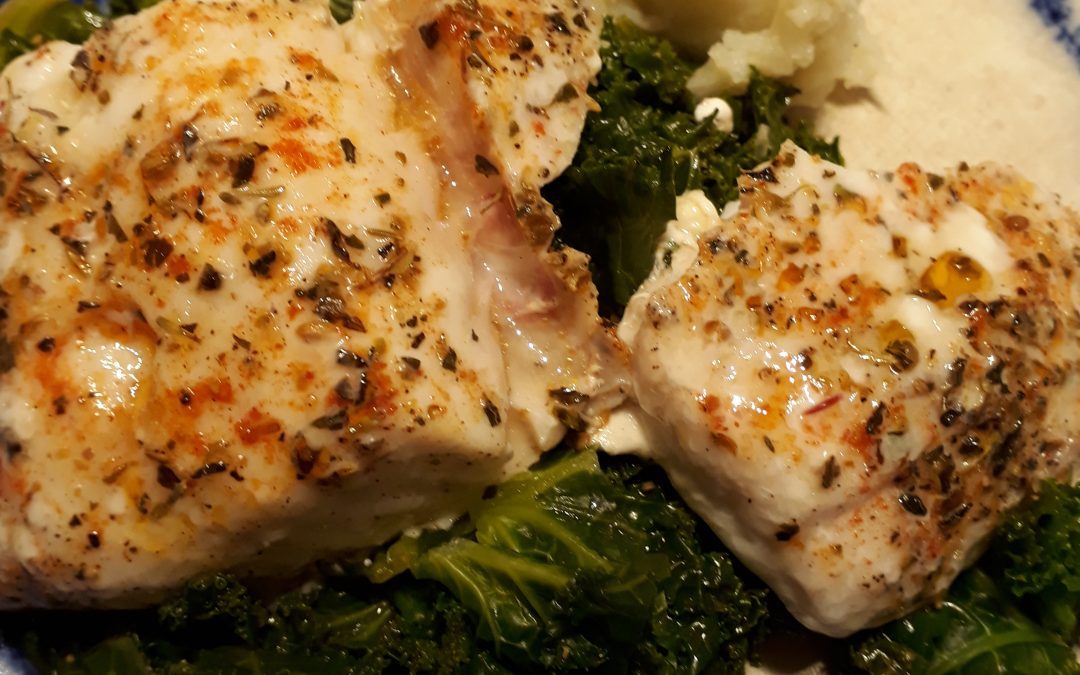

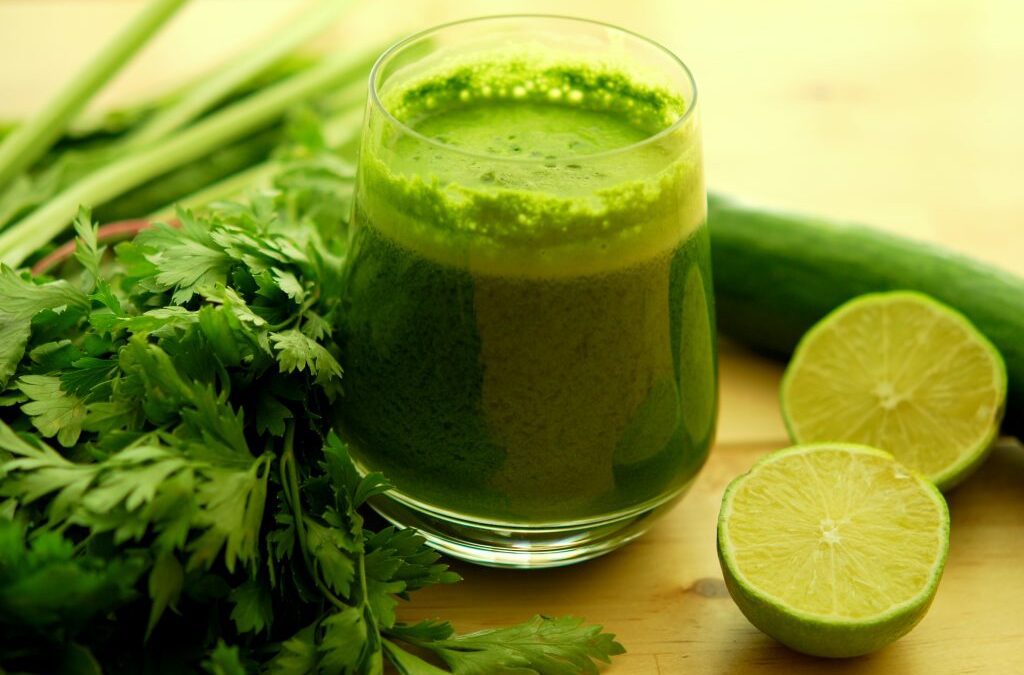
 How do you increase your veggie intake to help your health if you have almost no time in the evenings to prepare a full meal or you have problems chewing? Try these green smoothies. You can even make two servings and store leftovers in an airtight glass jar in the fridge for the next day. Citrus juice and airtight containers help prevent oxidation (nutrient loss and discolouration). If you don’t like your green smoothies cold you can heat these VERY gently in a saucepan until they are lukewarm.
How do you increase your veggie intake to help your health if you have almost no time in the evenings to prepare a full meal or you have problems chewing? Try these green smoothies. You can even make two servings and store leftovers in an airtight glass jar in the fridge for the next day. Citrus juice and airtight containers help prevent oxidation (nutrient loss and discolouration). If you don’t like your green smoothies cold you can heat these VERY gently in a saucepan until they are lukewarm.